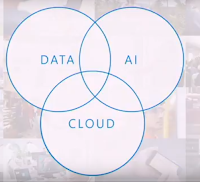I
attended Big Data London 15-16 Nov 2017 with leading data &
analytics experts showcasing their tools to help with delivering data-driven
strategy. The conference showcased the
fourth industrial revolution report which
explains what the UK’s data leaders think about the state of the UK data
economy.
A
summary of things I found interesting during the two day event are summarized
here.
Machine
Learning is such a topical discussion point, but it is not that difficult to get
started. An area to initially look at is co-occurrence and recommendation. Co-occurrence helps you find behaviours and you
can use that to find recommendations in areas such as textual analysis and
intrusion detection.
Machine learning
was described as the integration between analytics and operations. The three
questions to ask were: what algorithm, what tools and what process. 90% of machine
learning success is in data logistics (being able to handle lots of data types),
not learning.
The CDO’s playbook was launched. The Chief Data
Officer is a rapidly expanding role and this book offers practical advice on
what this role is, how it fits into to other c-suite roles and provides
actionable tips.
There are many challenges
when dealing with citizen data. At the heart of audiences is
- single view
of the customer
- deeper engagement
- supported intelligence
- relationship
management
The main
challenge is data quality and having a high enough quality of data to provide
insight.
Citizens want
to be data scientists and be able to dive into the data with ease. This self-service
model can have challenges. Better governance, data management and operational efficiency
are required together with the rise of managed service to remove the complexities
of running these services.
The keynote on
day 2, machine learning, AI and the future of big data analytics by Dr Amr
Awadallah, Co-founder of Cloudera, talked about a history of waves.
- wave 1 automation of
knowledge transfer
- wave 2 automation of
food
- wave 3 automation of
discovery
- wave 4 making and
moving stuff (Industrial revolution)
- wave 5 automation of
processes (IT revolution)
- wave 6 automation of
decisions.
We are in wave
6 which is about collecting data and leveraging data to make decisions. It is
different from the BI wave where humans made decisions. The new wave is learning
how decisions are made and automating them. Things to
consider for success are
- build a
data driven culture
- develop the
right team and skills
- be agile/lean
in development
- leverage DevOps
for production
- right size
data governance
There were discussions about data narrative and telling a story to the audience. The five steps
learnt for better storytelling
- identify the
right data
- choose the
right visualizations
- calibrate
visuals to your message
- remove unnecessary
noise
- focus attention
on what’s important
Matt Aslett
talked on pervasive intelligence: the future of big data, machine learning and
IoT, the details of which have been published in a report. He discussed trends and implications of the AI automation spectrum. It will bring about fundamental and wide ranging
positive societal implication that will change the way we live, work, play,
transact and travel. He mentioned a risk of having a small number of platform
oriented companies that control the forces of production for generating value
from data. The 4sight report on the future of IT is coming soon and sounds an interesting
read.
Deep learning
demystified explained why neural networks, that are not new, have only just
come to the fore. It was because they were originally thought of as part of a
failed experiment. In fact, it was that they did not use enough data. For
supervised learning it works well with very large data sets. The key things to
think of when considering deep learning are that it
- must have
large data, a minimum of 10 million labels of data
- what level
of accuracy do you need?
- can something
simple work? – start with classical models such as linear models
The conference was useful and provided a wide range of discussions on high level data topics.


































